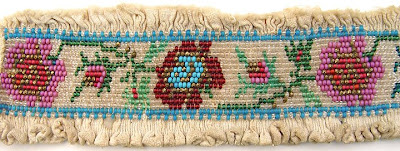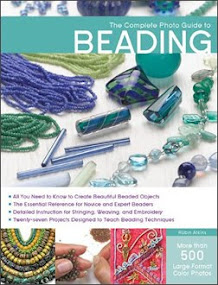My beading/quilting friends Christy and Lunnette introduced me to Colonial knots, assuring me that they're more secure than French knots. Christy says they're also easier than French knots. Maybe... after you've made quite a few. I agree however that for a consistent look and secure feel, Colonial knots take the cake. So all the knots on my Feb BJP are of the Colonial variety.

The difference? Here is how you make a French knot. The thread is wound around the needle. The more winds, the bigger the knot. Here is how you make a Colonial knot. The thread is passed in a figure-8 around the needle. The size is not variable.
Knots vs. seed beads... I guess one could argue that I could have achieved the same affect sewing a single bead in the same location as each knot. That would work too, although the look might be a bit less soft. I enjoyed the meditative time spent making all the background knots on my BJP piece.
Teaching
As many of you know, I'm not teaching much right now. The reason I always give is that my mother, who is 92 and lives in Minnesota (a day's flight from me), is not in the best of health. I don't want to promise someone I'll teach at their conference and risk the possibility of having to cancel at the last moment because Mom's health takes a turn for the worse.
Also there's a certain quality-of-life right now that I call being on hold. It's based on the certainty that before long I will not be a daughter any more and will not have any parents... I feel a little in limbo, uncertain and adrift, as though I've stopped living while waiting for the change, even though it isn't really imminent and surely I'll adjust once it happens.So this year, the second in a row for scaling back on teaching, I have only one definite gig. And that is just around the corner.
I will be teaching at the Bead Bazaar sponsored by the Rocky Mountain Bead Society in Denver, Colorado. Advance registration is open now. I'll be teaching:
- Woven Treasure Bracelet or Tassel on April 25
- Techniques of Bead Embroidery on April 26
- Visual Journaling with Beads, Fibers, Threads and Fabric
- View over 200 beaded journal pieces by 42 artists participating in the 2007-08 Bead Journal Project!
- Compelling and inspirational, this unique beadwork tells stories, reveals emotions and follows important events in the lives of the artists who create a visual journal each month during the year-long project.
- In this presentation, you will see some of the best!
Colorado beaders are wonderful! I've taught there previously and been very impressed with the level of skill and artistry. Several BJP members live in Colorado, including:
There's also a possibility that I'll be teaching during the first week of October in Arizona. Stay tuned on that one!Clues ~ Mystery Beadwork
Here is a post showing beautiful fragments of historical bead embroidery, weaving and smocking that I bought 15 or so years ago. The origins of this 100+ year old beading were unknown by the seller, except that he bought it from a peddler in Mexico City. In the post I asked for help in identifying the origins.
Help arrived! I'll post the complete findings in a later post. But, in summary, the work appears to be from Mexico, probably from the Nahua natives of the central Puebla area. My information comes from two main source books: La Chaquira en Mexico and Costumes of Mexico both of which are well illustrated, fascinating books. (By the way, la chaquira = beads!)
Just as a teaser, here is one of the pieces in my collection.

Here is a diagram from La Chaquira en Mexico showing the techinque for bead embellished pleating, as done by the Nahua natives.

And here is a picture from the same source showing a blouse made with this technique. Incidentally, I think this blouse is more recently made and with a slightly different technique than the fragments I have. Yet there certainly are similarities.

Choices
Are you familiar with Robert Glenn, the painter who writes a free newsletter about the artistic process, painting and issues affecting artists? I love reading his thought-provoking articles that come to my email once a week and thought I'd share a few words from his latest ~ about choices we make as artists. He writes:
Today I spoke on the phone to several colleagues. We were talking about planning versus improvisation. While many fine artists plan everything in detail and then simply execute, others admit they don't know what they're doing from the get-go, but they start anyway and spend a lot of time fixing up. Both systems work... The nice thing about choices is that they can be changed... The wayside choices we make, however minor or major, determine our signature, our style and our level of personal satisfaction.So, the ol' improv vs. plan question comes up in all aspects of art, I guess. What do you think of his point about our choices determining our style and level of personal satisfaction?

















Robin!
ReplyDeleteWhat awonderful post!!I am off to investigate Colonial Knots as I have had some frustration with the French knots- when they knot up!! I think that you are doing what is best for you and your family right now, in terms of scaling back on committments. There is a time for every purpose. ( I lvoe the Judy Collins version of this song, speaking of Colorado!!) If I ahd the $ knowing that this is one of your only teaching gigs , I would be there in a flash!! Many of us are in thsi transition time with our parents- My Mom is not as Old but at 76 she has had Type 1 Diabetes since she was 25 so physically she is pretty delicate. I am walking this path beside you in many ways though on the other side of the country. I am thinking of you and I stronly feelt aht it will become apparent to you that you are doing what is best for you!! Trying to avoid the trap of guilt is difficult. But on the other hand it is a very good thing to be in DEMAND!!
Hugs to you!!
Elizabeth
I'm still struggling with colonial knots - although I have a friend who swears by them. Probably the biggest drawback (I think) is that you can't vary the size and "fluffiness"? (is that a term?)
ReplyDeleteAnyway, glad you're coming to Denver, I'm off to post about you coming on my blog - I can't wait to take your class! Yay!
Great news about the mystery beadwork!
ReplyDeleteThanks for the referral to my blog for how to make the colonial knot. The size of the knot can vary greatly depending on the size of the needle shank and the weight of the thread. A fine needle with a fine thread will make a tiny knot while a fat shanked needle with a heavy or fluffy thread will result in fat puffy knots. The same applies to the French knot. Officially, only two or three wraps qualifies as a French knot. Additional wraps of the thread takes it into the bullion knot category.
ReplyDeleteAnd yes, I'm a big fan of the colonial knot. I like that the wrapping can be done up in the air, then the thread snugged into place against the fabric around the needle shaft before pulling the needle through to complete the stitch.
I know about life being on hold. That's why the internet is so important. Enjoy your mom. I still want to tell mine things-14 yrs. too late.
ReplyDeleteI like Robert Genn. He is so practical and just gets on with it rather than getting caught up in "art" issues.
I feel like I've been "on-hold" for years now. First it was my husbands' parents and then mine. It is hard to make any plans with parents in their 90s.
ReplyDeleteI like robert's newsletter too and find they often translate well into any art form, not just painting.
ReplyDeleteI started beading as a "planner", graphing my own designs for the peyote stitched bracelets I made with the japanese delica beads, but as the years rolled on, my style changed and now I''m almost 100% improvisational...I usually start with a focal point and then the dialogue between me and the piece begins! I find enormous joy and satisfaction in this process and when a piece "works" for me, I am so delighted!
Robin, loved reading your post. Glad to hear you found info on the mystery beadwork, I think I would agree it looks like you may have found the source. I think the way they used the fabric and beads was so clever, interesting and different! I am definitely going to try those colonial knots in place of some of my beads in the future. Thanks for the great post, and I know what you mean by putting your life on hold, my grandmother is 101 and she just keeps on keeping on, bless her heart.
ReplyDeleteMy life has been on hold for a long as I can remember, lol. If you look at my non-creative blog entry for today you will see it has been on hold for a very long time.
ReplyDeleteI can understand where you are coming from but maybe its just way of transistioning away from a life of teaching to being a person not ruled by the clock, calendar, whatever it is that keeps us on schedule. Maybe its a way of life you want to leave behind, which would be sad for all the people who attend your classes but equally it might be good for you.
with ref to the Robert Glenn improv vs planning, I suspect all creative people are a combination of both approaches. I like to plan to a degree but once I get started I like to see where the idea takes me.
I smiled when I read this post because I DO get that newsletter every week and I had read this one...but I hadn't viewed it in terms of my bead journal project? Somehow now, the meaning is different. Glad to see you've got a teaching gig and I WISH I could see that presentation AGAIN -- It was really well done and will be a delight for all who are lucky to hear you speak.
ReplyDeleteLas chiquiras (?) are calling my name -- I've enjoyed following this beading mystery...it does make me want to try it -- I wonder how they got their pleats so even -- maybe the beads help with that...Lots of love and anticipation for your visit, Susan
Colonial knots are just fantastic. Thanks for bringing them to my attention. Have you tried doing them with silk ribbon? Someone from Canada sent me a bag of silk ribbon, and I haven't tried working with it.
ReplyDeleteI actually had come to the conclusion that I really do need a little more "plan" when I start a new project. I actually bought a sketch book to start using. My husband, engineer type, is thrilled as he has aways told me that planning & laying out patterns is important. I've pretty much winged it up to now, but realize that I might get my subconscious working a little better if I feed it fuel over a long period of time. The fingers love to work, be the brain must be awake at times. I'm trying to get my brain out of the slumber phase.
dot